Become a donor or member and support our work to advance access to medicines. For everyone. Everywhere
A number of pricing strategies can improve access to affordable, needed medicines, but it can be difficult for policymakers to determine which approach to take. All strategies have strengths and weaknesses—and all countries have unique medicine needs and contexts. Countries must therefore assess their own medicines situation and use different combinations of strategies.
To help policymakers make informed choices, Health Action International has published a series of reviews and policy briefs on pricing strategies. These resources are derived from systematic literature reviews and analyses of policy issues and options. We don’t recommend one pricing strategy over another. Instead, we provide an objective description of the advantages and disadvantages of each approach, along with other important considerations that policymakers should assess.
Review 1: External Reference Pricing
External reference pricing is the practice of using the price of a 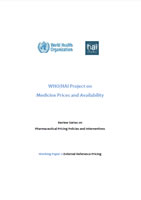
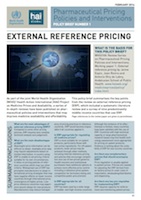 medicine in one or several countries to derive a benchmark or reference price for setting or negotiating the price of the medicine in a country. These materials outline where and how external reference pricing is used, its direct and indirect effects, whether it is an appropriate price regulation mechanism, components of an external reference pricing system, and more.
medicine in one or several countries to derive a benchmark or reference price for setting or negotiating the price of the medicine in a country. These materials outline where and how external reference pricing is used, its direct and indirect effects, whether it is an appropriate price regulation mechanism, components of an external reference pricing system, and more.
We’ve mapped the use of external reference pricing around the world. Click here to learn which countries use it, the structure and processes they use, and which low- and lower to middle-income countries are being referenced to by wealthier nations.
Review 2: The Role of Health Insurance in the Cost-effective Use of Medicines
Insurance systems have great potential to improve the 
 cost-effective use of medicines by leveraging better prescribing, more cost-effective medicine use by consumers and lower prices from pharmaceutical companies. The paper discusses product selection strategies (such as formularies and generic substitution policy), product purchasing strategies, reimbursement design and contracting strategies (financial incentives, separating prescribing and dispensing, and more), and utilisation management strategies (such as educational campaigns). The review includes four case studies. The paper discusses product selection strategies (such as formularies and generic substitution policy), product purchasing strategies, reimbursement design and contracting strategies (financial incentives, separating prescribing and dispensing, and more), and utilisation management strategies (such as educational campaigns). The review includes four case studies.
cost-effective use of medicines by leveraging better prescribing, more cost-effective medicine use by consumers and lower prices from pharmaceutical companies. The paper discusses product selection strategies (such as formularies and generic substitution policy), product purchasing strategies, reimbursement design and contracting strategies (financial incentives, separating prescribing and dispensing, and more), and utilisation management strategies (such as educational campaigns). The review includes four case studies. The paper discusses product selection strategies (such as formularies and generic substitution policy), product purchasing strategies, reimbursement design and contracting strategies (financial incentives, separating prescribing and dispensing, and more), and utilisation management strategies (such as educational campaigns). The review includes four case studies.
Review 3: The Regulation of Mark-ups in the Pharmaceutical Supply Chain
Mark-ups in the supply chain are variable, and often unregulated in 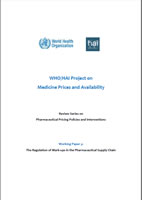
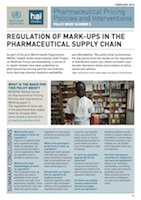 low- and middle-income countries. This can result in patients paying more than double the manufacturer’s selling price for a medicine. This paper reviews the evidence on the extent of mark-ups regulations, different approaches in regulating wholesaler and retailer mark-ups, the viability of wholesalers and pharmacies, enforcement issues, the impact on medicine prices and more. Three case studies are included. This paper reviews the evidence on the extent of mark-ups regulations, different approaches in regulating wholesaler and retailer mark-ups, the viability of wholesalers and pharmacies, enforcement issues, the impact on medicine prices and more. Three case studies are included. This paper reviews the evidence on the extent of mark-ups regulations, different approaches in regulating wholesaler and retailer mark-ups, the viability of wholesalers and pharmacies, enforcement issues, the impact on medicine prices and more. Three case studies are included.
low- and middle-income countries. This can result in patients paying more than double the manufacturer’s selling price for a medicine. This paper reviews the evidence on the extent of mark-ups regulations, different approaches in regulating wholesaler and retailer mark-ups, the viability of wholesalers and pharmacies, enforcement issues, the impact on medicine prices and more. Three case studies are included. This paper reviews the evidence on the extent of mark-ups regulations, different approaches in regulating wholesaler and retailer mark-ups, the viability of wholesalers and pharmacies, enforcement issues, the impact on medicine prices and more. Three case studies are included. This paper reviews the evidence on the extent of mark-ups regulations, different approaches in regulating wholesaler and retailer mark-ups, the viability of wholesalers and pharmacies, enforcement issues, the impact on medicine prices and more. Three case studies are included.
Review 4: Competition Policy
Competition can reduce medicine prices and increase availability if 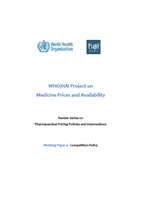
 the right conditions are in place. This paper looks at competition in the pharmaceutical sector and the role of competition law (including the effects of competition on prices, common problems with the functioning on the medicines market, examples of applying competition law to manufacturers of originator brands, generic manufacturers, retail pharmacies). Health sector policies and practices that affect competition are reviewed—those that can support competition (such as generics and public procurement policies) and those that can limit competition (like trade and industry protection policies). The paper includes a comprehensive case study on competition law in South Africa. Health sector policies and practices that affect competition are reviewed—those that can support competition (such as generics and public procurement policies) and those that can limit competition (like trade and industry protection policies). The paper includes a comprehensive case study on competition law in South Africa.
the right conditions are in place. This paper looks at competition in the pharmaceutical sector and the role of competition law (including the effects of competition on prices, common problems with the functioning on the medicines market, examples of applying competition law to manufacturers of originator brands, generic manufacturers, retail pharmacies). Health sector policies and practices that affect competition are reviewed—those that can support competition (such as generics and public procurement policies) and those that can limit competition (like trade and industry protection policies). The paper includes a comprehensive case study on competition law in South Africa. Health sector policies and practices that affect competition are reviewed—those that can support competition (such as generics and public procurement policies) and those that can limit competition (like trade and industry protection policies). The paper includes a comprehensive case study on competition law in South Africa.
Review 5: Sales Taxes on Medicines
Many governments apply value-added and other taxes on medicine 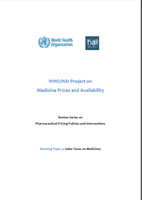
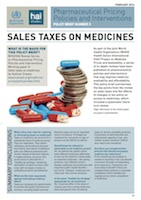 to generate revenue. This paper discusses the impact of these taxes on access to care. The economic case for taxing and not taxing medicines, as well as well as healthier ways to raise public revenue, are also discussed. This paper discusses the impact of these taxes on access to care. The economic case for taxing and not taxing medicines, as well as well as healthier ways to raise public revenue, are also discussed. This paper discusses the impact of these taxes on access to care. The economic case for taxing and not taxing medicines, as well as well as healthier ways to raise public revenue, are also discussed. This paper discusses the impact of these taxes on access to care. The economic case for taxing and not taxing medicines, as well as well as healthier ways to raise public revenue, are also discussed.
to generate revenue. This paper discusses the impact of these taxes on access to care. The economic case for taxing and not taxing medicines, as well as well as healthier ways to raise public revenue, are also discussed. This paper discusses the impact of these taxes on access to care. The economic case for taxing and not taxing medicines, as well as well as healthier ways to raise public revenue, are also discussed. This paper discusses the impact of these taxes on access to care. The economic case for taxing and not taxing medicines, as well as well as healthier ways to raise public revenue, are also discussed. This paper discusses the impact of these taxes on access to care. The economic case for taxing and not taxing medicines, as well as well as healthier ways to raise public revenue, are also discussed.
Review 6: Health Technology Assessment in Medicine Pricing and Reimbursement
Health technology assessment (HTA) of medicines assesses 
 whether a new medicine provides any additional benefit compared with current practice and at what additional cost. Countries that are part of the Organization for Economic Co-operation and Development (OECD) widely use HTA findings to inform decisions about formularies, prices and the reimbursement of medicines. Interest in HTA has expanded. A number of middle-income countries have now established HTA agencies, or commission HTA from academic or other institutions. This review outlines the role of HTA and its implementation (including capacity needs, challenges, applying HTAs undertaken in other countries). Interest in HTA has expanded. A number of middle-income countries have now established HTA agencies, or commission HTA from academic or other institutions. This review outlines the role of HTA and its implementation (including capacity needs, challenges, applying HTAs undertaken in other countries).
whether a new medicine provides any additional benefit compared with current practice and at what additional cost. Countries that are part of the Organization for Economic Co-operation and Development (OECD) widely use HTA findings to inform decisions about formularies, prices and the reimbursement of medicines. Interest in HTA has expanded. A number of middle-income countries have now established HTA agencies, or commission HTA from academic or other institutions. This review outlines the role of HTA and its implementation (including capacity needs, challenges, applying HTAs undertaken in other countries). Interest in HTA has expanded. A number of middle-income countries have now established HTA agencies, or commission HTA from academic or other institutions. This review outlines the role of HTA and its implementation (including capacity needs, challenges, applying HTAs undertaken in other countries).
Review 7: Policy Options for Promoting the Use of Generic
Medicines in Low- and Middle-income Countries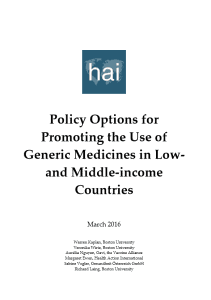
Use of lower-priced quality-assured generics is key to improving access to medicines. This review of the literature shows a wide range of policies are used to promote the uptake of generics. Information is given on the impact of each policy where known. Three over-arching enabling conditions are also discussed that must be introduced before a country can effectively implement pro-generic medicine policies.